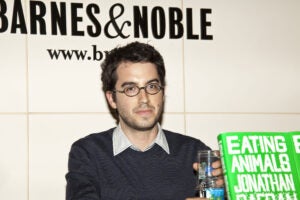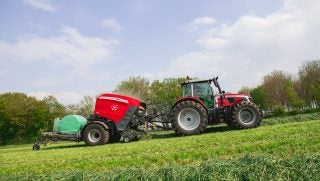During a private audience with Pope Francis, best-selling author and animal-rights advocate Jonathan Safran Foer gave a presentation about eating fewer animal products as an important way he sees to reduce global climate change.
Foer, who grew up in a Jewish household, is the author of 2009’s Eating Animals, his own moral examination of eating animals while “traveling to the darkest corners of our dining habits,” according to the book description. His audience with the pope was a response to the Catholic Church’s new Apostolic Exhortation, Laudaute Deum, a call to action to address the climate crisis from both a scientific and humanitarian standpoint.
The document, in part, says:
“Despite all attempts to deny, conceal, gloss over or relativize the issue, the signs of climate change are here and increasingly evident. No one can ignore the fact that in recent years we have witnessed extreme weather phenomena, frequent periods of unusual heat, drought and other cries of protest on the part of the earth that are only a few palpable expressions of a silent disease that affects everyone. Admittedly, not every concrete catastrophe ought to be attributed to global climate change. Nonetheless, it is verifiable that specific climate changes provoked by humanity are notably heightening the probability of extreme phenomena that are increasingly frequent and intense.”
Foer said that meat reduction and food systems reform were powerful ways to respond to the pope’s call. He emphasized the need for policy level change, and following the pope’s lead, argued that individual actions are often what motivates governmental action.

What is unclear from Foer — a founding board member of Farm Forward, a nonprofit that works to restrict animal agriculture — is whether his advocacy is strictly moral or if he believes it is science-based.
For example in the U.S., cattle’s methane impact is significantly less than 50 years ago and continues to reduce because of efficiency gains in producing beef and milk. In 1970, 12.5 million milk cows produced 117.4 million pounds of milk. In 2019, 9.3 million cows produced 218.4 million pounds — 86 percent more milk from 26 percent less cows. Just since January 2000, milk production per cow has risen 28 percent and the dairy industry now produces 30 percent more milk on just slightly more cows.
According to the U.S. Environmental Production Agency, agriculture as a whole accounts for 9 percent of U.S. emissions, with animal agriculture being just a third of that — the fossil-fuel-heavy industries of transportation and electricity are far worse in terms of emissions. But while livestock production might be doing well in the U.S., that’s not to say that producers globally are as dialed in to improvements and sustainability.
“What Pope Francis has done is enormously brave. I found myself deeply moved by Laudate Deum, its decisive call to action, and its bright moral core,” Foer said. “It emboldened my sense of the possible and of the meaning of individual actions. It reminded me of the deep roots of my own vegetarian commitments and why all of us need to support a more plant-based food system.”
Livestock production has been a target in the climate change debate for years, with its role in the Green New Deal in 2019 as one of the biggest discussion points.
“As a rancher, I can tell you that we take the quality of the great outdoors very seriously — air, soil and water quality are all of utmost importance to us here because, well we are the ones living here in the sticks,” Kansas rancher Brandi Buzzard Frobose said in viral response to the Green New Deal. “Which is why our segment of agriculture actively works to reduce our impact on the environment every. single. day.”
Beef producers in the U.S. now have one of the lowest carbon footprints compared to many of their worldwide counterparts.
Laudate Deum does not get into the specifics of how to respond to climate change, though the pope has spoken previously against cruelty to animals but not against livestock production, per se. Many farmers and ranchers see value in what ruminants (such as cattle) bring to the table in terms of carbon capture.
Methane, from a scientific standpoint, contains one carbon atom and four hydrogen atoms. The carbon atom a ruminant belches came from the carbon dioxide a plant took from the atmosphere. The methane released from the rumen will decay back to carbon dioxide after 10 to 12 years of roaming around the atmosphere.
This cycle has been going on for thousands of years as the ruminant family, which includes cattle for meat and milk, cattle for draft work, sheep, goats, elk, deer, antelope, bison, wildebeests, giraffes, etc., grazed the Earth’s grasslands and burped methane. Experts have said that, considering the large herds of bison (60 million to 100 million) and other grazers that existed before humans replaced most of them with cattle, it can be assumed the methane in the atmosphere from ruminants of all types has not changed much in tens of thousands of years.


